Tactical Home Defense: Neighborhood Security
Tactical Home Defense & Security: Neighborhood Security
This short article discusses several important points regarding neighborhood security as well as some potential considerations when attempting to establish a neighborhood level security alert and emergency response plan.
Our Tactical Home Defense and Security training goes into detail on a wide range of topics relating to home defense while providing examples of effective tactics and techniques that can help you protect yourself and your family.
Our Tactical Home Defense and Security training goes into detail on a wide range of topics relating to home defense while providing examples of effective tactics and techniques that can help you protect yourself and your family.
No security measure is a magical forcefield that actively protects you from threats. The best alarm system in the world doesn’t provide any security or deterrence effect if there is no one to respond to the alarm. The most heavily fortified door can be completely useless if left unlocked, or if the threat has an unlimited amount of time to find a way to break through it. Owning a firearm and spending countless hours training with it will ultimately not do any good if an intruder breaks into your home while you are sound asleep in your bed and your weapon is in another room.
In order for security to be effective, three critical elements need to come together simultaneously: alert, hardening and response.
In order for security to be effective, three critical elements need to come together simultaneously: alert, hardening and response.
Write your awesome label here.
Tactical Home Defense Training Course
This course adapts combat-tested military principles and tactics to the mission of civilian home defense & security. The concepts and techniques presented can also apply to a wide range of situations and threat environments.
An alert system might be an alarm system, a neighborhood watch, a pet, a combination of all three or any number of other alert devices. The alert system's purpose is to notify you when there is a threat or potential threat. The alert system usually works in conjunction with physical obstacles and the measures you take to harden your home. Installing a door with a lock, means that you can connect an alarm that goes off when that door is opened.
Next is hardening - establishing obstacles and emplacing challenges to thwart or slow an intruder, and/or trigger other security elements. For example, installing a properly secured deadbolt on your door can force a threat to repeatedly beat or kick on your door, or break a window, in order to enter. This will wake up your guard dog who then barks and alerts you to the threat. As you can see, alert systems and obstacles / hardening typically work as a layered approach in conjunction with one another.
The third element is the response. The response could be police quickly arriving on scene; or, increasingly more likely, it may very well be you or other family members forced to engage the threat yourself with a personally owned weapon in order to protect and defend yourselves long before the police arrive. In any case, it is important to integrate your alert system with your physical obstacles and threat response plan.
This article will discuss a few important points on how to integrate a neighborhood level alert system with a community response plan.
Layers of Alert Systems
When establishing and emplacing alert systems, it can be helpful to think of them in terms of layers. The more layers of alert systems you have and the farther out they reach, the earlier warning you will have to prepare for or react to an incoming threat.
Multiple layers of alert systems also decrease the chances that a threat will pass through undetected.
The picture below shows a neighborhood (the blue outline) and your personal property (green outline) within that neighborhood. The red outline identifies the exterior walls of your family dwelling. As we'll discuss, you can incorporate different types of alert systems into each of these three zones.
While your neighborhood, property and home may differ from the example in various ways, in most cases the fundamental principles of security remain the same.
Multiple layers of alert systems also decrease the chances that a threat will pass through undetected.
The picture below shows a neighborhood (the blue outline) and your personal property (green outline) within that neighborhood. The red outline identifies the exterior walls of your family dwelling. As we'll discuss, you can incorporate different types of alert systems into each of these three zones.
While your neighborhood, property and home may differ from the example in various ways, in most cases the fundamental principles of security remain the same.
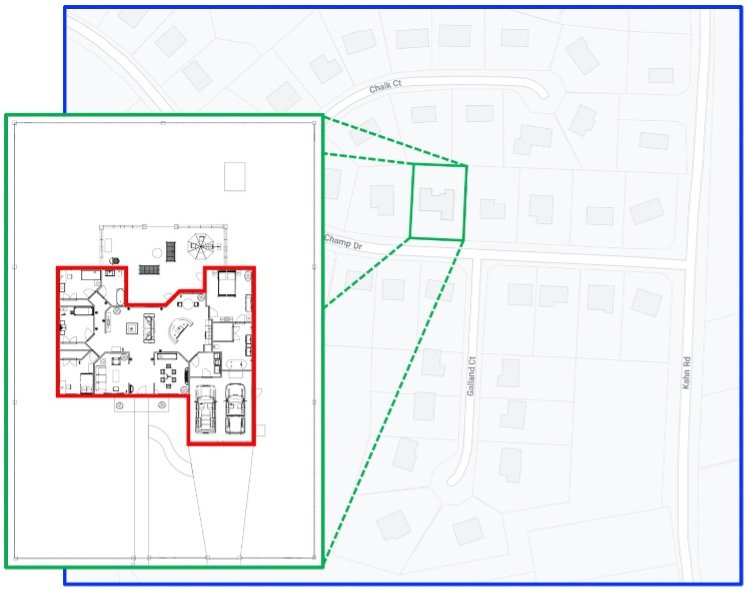
Contact Roster and Grid Reference Graphic
Do you know your neighbors? Maintaining good communication between residents in a neighborhood is essential for effective security. In some cases, people do not even know their next-door neighbor’s phone number. In other cases, neighbors may have no communication or interaction at all. This can be very detrimental to neighborhood security, and can cause serious problems in an emergency situation.
What if you are away from home and a child or older relative calls you for help? Wouldn’t it be helpful to be able to reach out to a trusted neighbor to assist right away? What if you detect a possible prowler but lose sight of the threat behind a neighbor’s house? Wouldn’t you want to warn the neighbor and ask them what they see? Wouldn't you likewise want your neighbor to alert you if the situation were reversed?
Who would know better if something was amiss, suspicious or didn't belong in a neighborhood than the people who live in that neighborhood?
By establishing a “common operating picture” within your neighborhood you can greatly enhance your overall security and alert capabilities. One method of doing this is by establishing a Grid Reference Graphic (GRG) document like the one below and sharing it with your neighborhood. The GRG document includes a phone roster of everyone in the neighborhood and depicts where each person’s house is with a number. There is also a simple alphanumeric grid to help neighbors quickly communicate the location of possible threats. You might call a neighbor and ask "Do you see a suspicious vehicle in the area of grid L21?" That can be much quicker and easier than trying to describe a location, especially at night.
What if you are away from home and a child or older relative calls you for help? Wouldn’t it be helpful to be able to reach out to a trusted neighbor to assist right away? What if you detect a possible prowler but lose sight of the threat behind a neighbor’s house? Wouldn’t you want to warn the neighbor and ask them what they see? Wouldn't you likewise want your neighbor to alert you if the situation were reversed?
Who would know better if something was amiss, suspicious or didn't belong in a neighborhood than the people who live in that neighborhood?
By establishing a “common operating picture” within your neighborhood you can greatly enhance your overall security and alert capabilities. One method of doing this is by establishing a Grid Reference Graphic (GRG) document like the one below and sharing it with your neighborhood. The GRG document includes a phone roster of everyone in the neighborhood and depicts where each person’s house is with a number. There is also a simple alphanumeric grid to help neighbors quickly communicate the location of possible threats. You might call a neighbor and ask "Do you see a suspicious vehicle in the area of grid L21?" That can be much quicker and easier than trying to describe a location, especially at night.
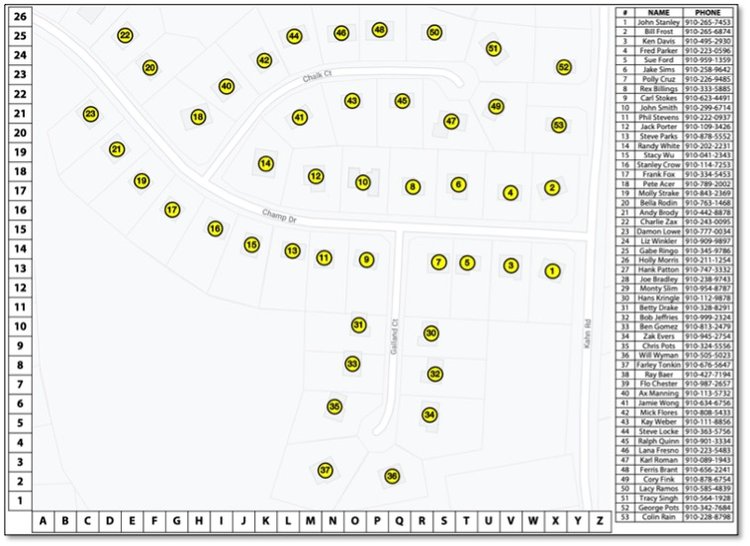
Redundant Alert Plans
After improving communications in your neighborhood and creating some shared documents like call rosters or GRGs, it is important to actually talk with your neighbors, get to know them, and agree upon some prearranged emergency signals.
You may divide up the phone roster into an alert tree and assign each neighbor three others to call in an emergency that affects the entire neighborhood. You might plan to contact specific neighbors with law enforcement or medical experience depending on the situation.
What if there is an emergency and your phone does not work? It would be helpful to have a whistle or airhorn to alert neighbors of the emergency. If you have some established form of prearranged signal (three air horn blasts for emergency etc.) the neighbors can then call the police even if you cannot.
When establishing alerts, it is critically important to also test them. As shown in the diagram below, the sound of a whistle or air horn might only travel so far. It is also important to have electronic alarms (marked in blue) that are quick to trigger and directly alert a security company or local law enforcement. These are just a few examples of how to set up an alert plan within your neighborhood.
There is no single best way to do this. The general layout, building density, and numerous other characteristics of your specific neighborhood will affect what works best for you. The important thing is to think through it, discuss it with your neighbors and then test and refine your solution to ensure it works effectively and everyone understands the plan.
You may divide up the phone roster into an alert tree and assign each neighbor three others to call in an emergency that affects the entire neighborhood. You might plan to contact specific neighbors with law enforcement or medical experience depending on the situation.
What if there is an emergency and your phone does not work? It would be helpful to have a whistle or airhorn to alert neighbors of the emergency. If you have some established form of prearranged signal (three air horn blasts for emergency etc.) the neighbors can then call the police even if you cannot.
When establishing alerts, it is critically important to also test them. As shown in the diagram below, the sound of a whistle or air horn might only travel so far. It is also important to have electronic alarms (marked in blue) that are quick to trigger and directly alert a security company or local law enforcement. These are just a few examples of how to set up an alert plan within your neighborhood.
There is no single best way to do this. The general layout, building density, and numerous other characteristics of your specific neighborhood will affect what works best for you. The important thing is to think through it, discuss it with your neighbors and then test and refine your solution to ensure it works effectively and everyone understands the plan.
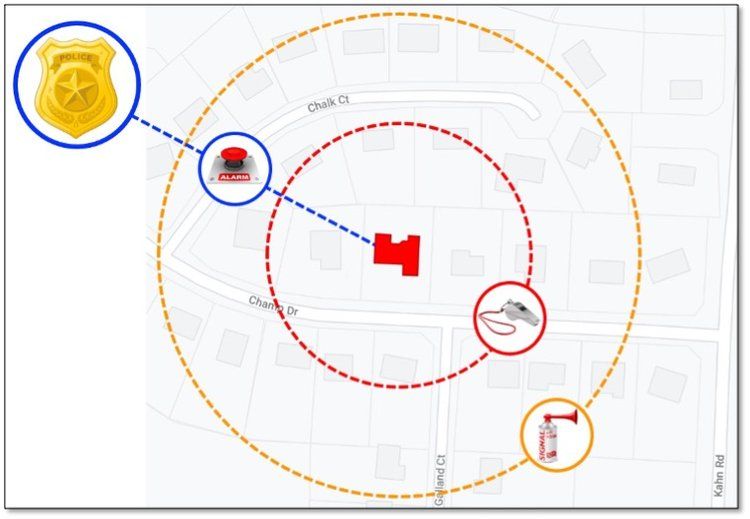
Personal Communications Plan
Quickly and effectively communicating an emergency alert is one thing, but being able to communicate is also vitally important in an emergency. Therefore, you should ensure you also have multiple, redundant methods of communication within your own home.
Following the same principles of military "P.A.C.E." communications planning, you should ideally have four levels of forms of communication: Primary, Alternate, Contingency and Emergency. Study the diagram below for an example.
It can be helpful to have cordless or wired land-line phones as a contingency option in case cell reception goes down. Providing each family member a portable radio (walkie-talkie) can allow you to communicate with your family without requiring cell service, or while calling the police on another line. If you have an alarm system, you should be able to manually trigger the alarm from several points throughout the house, and particularly from hardened emergency / fallback locations or "safe rooms." You should also have backup alert and communications devices placed in strategic locations so you can get to them in an emergency. Everyone in the family must know where these devices are and you must test them and practice using them regularly. Don't forget to also periodically inspect and replace batteries to ensure the devices will function when you need them to during an actual emergency.
Following the same principles of military "P.A.C.E." communications planning, you should ideally have four levels of forms of communication: Primary, Alternate, Contingency and Emergency. Study the diagram below for an example.
It can be helpful to have cordless or wired land-line phones as a contingency option in case cell reception goes down. Providing each family member a portable radio (walkie-talkie) can allow you to communicate with your family without requiring cell service, or while calling the police on another line. If you have an alarm system, you should be able to manually trigger the alarm from several points throughout the house, and particularly from hardened emergency / fallback locations or "safe rooms." You should also have backup alert and communications devices placed in strategic locations so you can get to them in an emergency. Everyone in the family must know where these devices are and you must test them and practice using them regularly. Don't forget to also periodically inspect and replace batteries to ensure the devices will function when you need them to during an actual emergency.
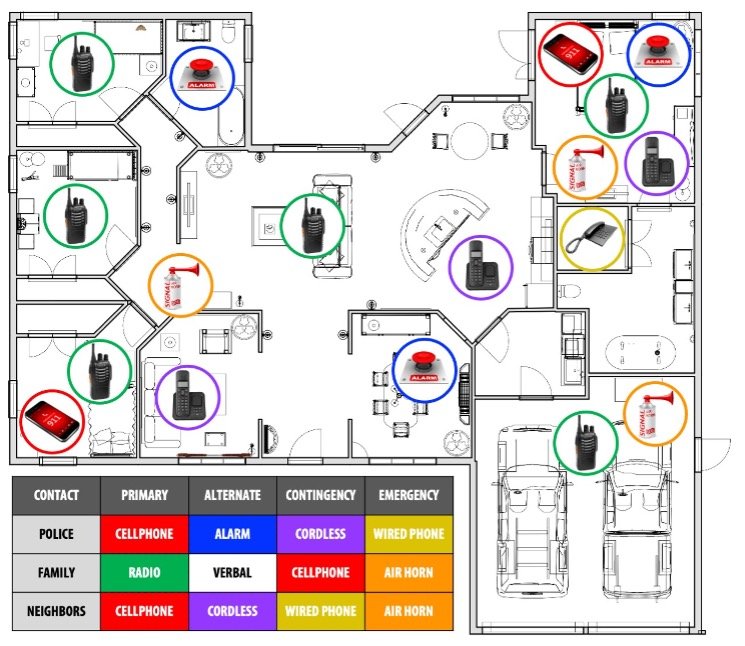
Neighborhood Emergency Response Plan
In some cases, local law enforcement will be too far away to respond quickly enough in an emergency.
When you are making your personal or family defense plan and laying out your timeline, you might find that no matter how many sensors or obstacles you emplace, you cannot realistically slow an intruder down long enough for police to arrive. In this case, you must find or plan for other ways to respond to the threat.
Even if police are close by, it is still a good idea to develop neighborhood response capabilities and procedures. One of the most basic involves highlighting the names and houses of certain key individuals in your neighborhood on your GRG.
In a disaster event or large scale catastrophe, emergency services will quickly be stretched thin and may not be available to respond for some time. However, there may be qualified individuals in your own neighborhood that can provide more immediate assistance.
In the example below, individuals with law enforcement, military or combat/weapons experience are highlighted in blue, whereas individuals with medical experience are highlighted in red. If you yourself are not skilled or confident with a firearm, a skilled and experienced neighbor might be able to come to the rescue in a very short time window. Of course, these designated "neighborhood responders" should coordinate with local law enforcement as much as possible to prevent potential confusion and accidents. Likewise, a trained medical professional might be able to arrive quickly in time to provide critical life-saving care long before an ambulance or paramedics can arrive on scene.
If you do elect to develop this type of neighborhood response plan, the more advance planning you can conduct the better. Such planning might include ensuring trusted, qualified responders have a binder with all of the neighborhood home floorplans and family defense plans. If an emergency takes place in a given house, the responder can quickly pull the laminated floorplan of that location and immediately know the family’s planned escape routes and hide locations. This is just one example of a planning measure that might mitigate risk in an emergency.
When you are making your personal or family defense plan and laying out your timeline, you might find that no matter how many sensors or obstacles you emplace, you cannot realistically slow an intruder down long enough for police to arrive. In this case, you must find or plan for other ways to respond to the threat.
Even if police are close by, it is still a good idea to develop neighborhood response capabilities and procedures. One of the most basic involves highlighting the names and houses of certain key individuals in your neighborhood on your GRG.
In a disaster event or large scale catastrophe, emergency services will quickly be stretched thin and may not be available to respond for some time. However, there may be qualified individuals in your own neighborhood that can provide more immediate assistance.
In the example below, individuals with law enforcement, military or combat/weapons experience are highlighted in blue, whereas individuals with medical experience are highlighted in red. If you yourself are not skilled or confident with a firearm, a skilled and experienced neighbor might be able to come to the rescue in a very short time window. Of course, these designated "neighborhood responders" should coordinate with local law enforcement as much as possible to prevent potential confusion and accidents. Likewise, a trained medical professional might be able to arrive quickly in time to provide critical life-saving care long before an ambulance or paramedics can arrive on scene.
If you do elect to develop this type of neighborhood response plan, the more advance planning you can conduct the better. Such planning might include ensuring trusted, qualified responders have a binder with all of the neighborhood home floorplans and family defense plans. If an emergency takes place in a given house, the responder can quickly pull the laminated floorplan of that location and immediately know the family’s planned escape routes and hide locations. This is just one example of a planning measure that might mitigate risk in an emergency.
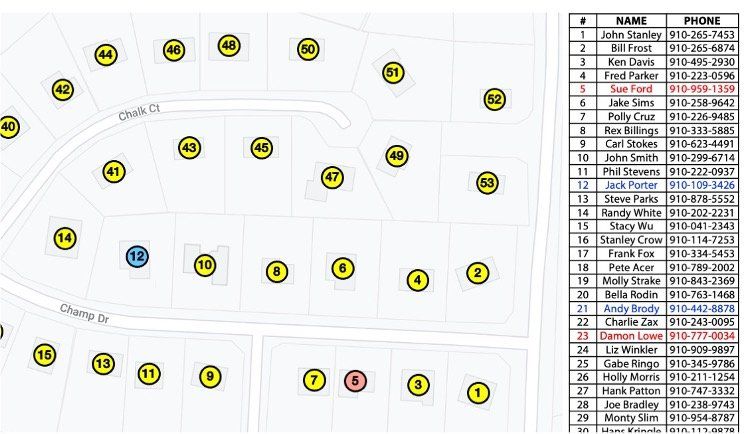
Other articles in the Tactical Home Defense article series will cover a wide variety of topics related to the defense of your home and place of business, community defense planning, and more.
©Copyright Special Tactics, LLC. All rights reserved.
Iron Survival, LLC
Featured links
Policy Pages
©Copyright 2026 Iron Survival, LLC
